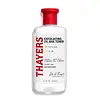What's inside
What's inside
 Key Ingredients
Key Ingredients

No key ingredients
 Benefits
Benefits

 Concerns
Concerns

 Ingredients Side-by-side
Ingredients Side-by-side

Salicylic Acid 2%
MaskingWater
Skin ConditioningSodium Borate
BufferingMelaleuca Alternifolia Leaf Oil
AntioxidantHamamelis Virginiana Bark/Leaf/Twig Extract
Skin ConditioningCymbopogon Flexuosus Oil
MaskingAloe Barbadensis Leaf Extract
EmollientAloe Barbadensis Leaf Juice
Skin ConditioningCocamidopropyl Betaine
CleansingGlycerin
HumectantCaprylyl Glycol
EmollientCitric Acid
BufferingDecyl Glucoside
CleansingEthylhexylglycerin
Skin ConditioningTocopherol
AntioxidantPhenoxyethanol
PreservativeGeraniol
PerfumingFarnesol
PerfumingLimonene
PerfumingCitral
PerfumingSalicylic Acid 2%, Water, Sodium Borate, Melaleuca Alternifolia Leaf Oil, Hamamelis Virginiana Bark/Leaf/Twig Extract, Cymbopogon Flexuosus Oil, Aloe Barbadensis Leaf Extract, Aloe Barbadensis Leaf Juice, Cocamidopropyl Betaine, Glycerin, Caprylyl Glycol, Citric Acid, Decyl Glucoside, Ethylhexylglycerin, Tocopherol, Phenoxyethanol, Geraniol, Farnesol, Limonene, Citral
Water
Skin ConditioningAloe Barbadensis Leaf Juice
Skin ConditioningVaccinium Myrtillus Fruit Extract
Skin ConditioningSodium Hydroxide
BufferingHamamelis Virginiana Water
AstringentSaccharum Officinarum Extract
MoisturisingChamomilla Recutita Flower Extract
MaskingAcer Saccharum Extract
Skin ConditioningCitrus Aurantium Dulcis Fruit Extract
MaskingCitrus Aurantium Dulcis Oil
MaskingCitrus Limon Fruit Extract
MaskingPvp
Emulsion StabilisingIsoceteth-20
EmulsifyingDisodium EDTA
Propylene Glycol
HumectantCitric Acid
BufferingPotassium Sorbate
PreservativeSodium Benzoate
MaskingPhenoxyethanol
PreservativeChlorphenesin
AntimicrobialLimonene
PerfumingWater, Aloe Barbadensis Leaf Juice, Vaccinium Myrtillus Fruit Extract, Sodium Hydroxide, Hamamelis Virginiana Water, Saccharum Officinarum Extract, Chamomilla Recutita Flower Extract, Acer Saccharum Extract, Citrus Aurantium Dulcis Fruit Extract, Citrus Aurantium Dulcis Oil, Citrus Limon Fruit Extract, Pvp, Isoceteth-20, Disodium EDTA, Propylene Glycol, Citric Acid, Potassium Sorbate, Sodium Benzoate, Phenoxyethanol, Chlorphenesin, Limonene
 Reviews
Reviews

Ingredients Explained
These ingredients are found in both products.
Ingredients higher up in an ingredient list are typically present in a larger amount.
Aloe Barbadensis Leaf Juice comes from leaves of the aloe plant. Aloe Barbadensis Leaf Juice is best known for helping to soothe sunburns. It is also anti-inflammatory, moisturizing, antiseptic, and can help heal wounds.
Aloe is packed with good stuff including Vitamins A, C, and E. These vitamins are antioxidants, which help fight free-radicals and the damage they may cause. Free-radicals are molecules that may damage your skin cells, such as pollution.
Aloe Barbadensis Leaf Juice also contains sugars. These sugars come in the form of monosaccharides and polysaccharides, folic acid, and choline. These sugars are able to help bind moisture to skin.
It also contains minerals such as calcium, 12 anthraquinones, fatty acids, amino acids, and Vitamin B12.
Learn more about Aloe Barbadensis Leaf JuiceCitric Acid is an alpha hydroxy acid (AHA) naturally found in citrus fruits like oranges, lemons, and limes.
Like other AHAs, citric acid can exfoliate skin by breaking down the bonds that hold dead skin cells together. This helps reveal smoother and brighter skin underneath.
However, this exfoliating effect only happens at high concentrations (20%) which can be hard to find in cosmetic products.
Due to this, citric acid is usually included in small amounts as a pH adjuster. This helps keep products slightly more acidic and compatible with skin's natural pH.
In skincare formulas, citric acid can:
While it can provide some skin benefits, research shows lactic acid and glycolic acid are generally more effective and less irritating exfoliants.
Most citric acid used in skincare today is made by fermenting sugars (usually from molasses). This synthetic version is identical to the natural citrus form but easier to stabilize and use in formulations.
Read more about some other popular AHA's here:
Learn more about Citric AcidLimonene is a fragrance that adds scent and taste to a formulation.
It's found in the peel oil of citrus fruits and other plants such as lavender and eucalyptus. The scent of limonene is generally described as "sweet citrus".
Limonene acts as an antioxidant, meaning it helps neutralize free radicals.
When exposed to air, oxidized limonene may sensitize the skin. Because of this, limonene is often avoided by people with sensitive skin.
The term 'fragrance' is not regulated in many countries. In many cases, it is up to the brand to define this term. For instance, many brands choose to label themselves as "fragrance-free" because they are not using synthetic fragrances. However, their products may still contain ingredients such as essential oils that are considered a fragrance.
Learn more about LimonenePhenoxyethanol is a preservative that has germicide, antimicrobial, and aromatic properties. Studies show that phenoxyethanol can prevent microbial growth. By itself, it has a scent that is similar to that of a rose.
It's often used in formulations along with Caprylyl Glycol to preserve the shelf life of products.
Water. It's the most common cosmetic ingredient of all. You'll usually see it at the top of ingredient lists, meaning that it makes up the largest part of the product.
So why is it so popular? Water most often acts as a solvent - this means that it helps dissolve other ingredients into the formulation.
You'll also recognize water as that liquid we all need to stay alive. If you see this, drink a glass of water. Stay hydrated!
Learn more about Water